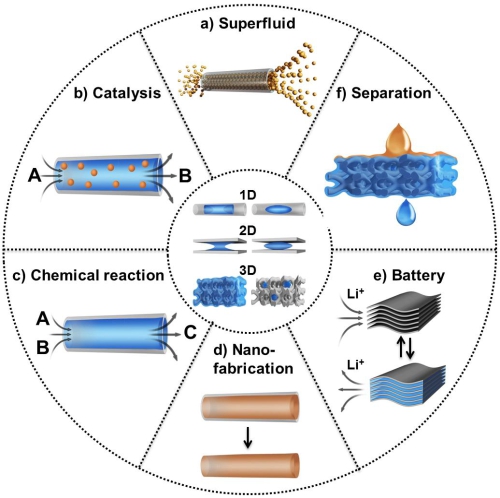Wettability in nanochannel is essential for understanding and conquering many remaining challenging problems in material science and technology, such as mass transport, catalysis, confined chemical reaction, nanofabrication, energy storage and conversion, and liquid separation. An important variable of nanochannel is represented by the diameter of the tube. On one hand, much attention has been paid to liquids inside the nanotubes with a diameter of several nanometers, which provides an opportunity to observe the non-continuum fluid dynamics owing to confinement. On the other hand, many researchers have utilized nanotubes with diameters larger than 10 nm for applications, which provide larger confined space for liquid to handle without experiencing non-continuum fluid behavior. Despite tremendous advances over the past two decades, many challenging problems on nanoconfined wettability and liquid flux still exist. The biggest obstacle is exploring the physical source of the anomalous behavior of confined liquids in nanochannels. Encouragingly, the nanotechnology in characterization is developed, and provides useful experimental evidences to understand the wettability mechanism on nanoconfined liquids, and prove to be an important step towards the applications of nanochannels.
Recently, Prof. Lei Jiang and Dr. Xiqi Zhang from Technical Institute of Physics and Chemistry of Chinese Academy of Sciences have published a review entitled “Wettability and Applications of Nanochannels” on Advanced Materials (Adv. Mater. 2018, 1804508). Their proposed concept of “quantum-confined superfluid” (QSF) for ultrafast mass transport in nanochannels is firstly introduced. Then, wettability in nanochannels including 1D nanochannels, 2D nanochannels and 3D nanochannels is summarized both theoretically and experimentally, from molecular simulation to water wettability, followed by reversible switching of water wettability via external stimuli. Liquid transport and two confinement strategies in nanochannels of melt wetting and liquid wetting are also included. Based on the wettability in nanochannels, broad applications of various nanochannels are presented. In the perspective, they point out that the QSF concept will not only provide a new way to understand the behavior of discontinuous fluids in nanochannels, but also lead to a revolution in QSF-based chemistry.
The article has been highly praised by the reviewers as “a topic far beyond the current border of knowledge”, and “correct, ground-breaking and super-innovative”, and “has the chance to become a game changer for future advanced fluid effects”. Meanwhile, the manuscript has been accepted for publication without change.

Figure. Wettability and Applications of Nanochannels (Image by Xiqi Zhang)
This work was supported by the National Key R&D program of China, the National Natural Science Foundation of China, and the 111 Project.
Link:https://onlinelibrary.wiley.com/doi/10.1002/adma.201804508
E-mail: xqzhang@mail.ipc.ac.cn

